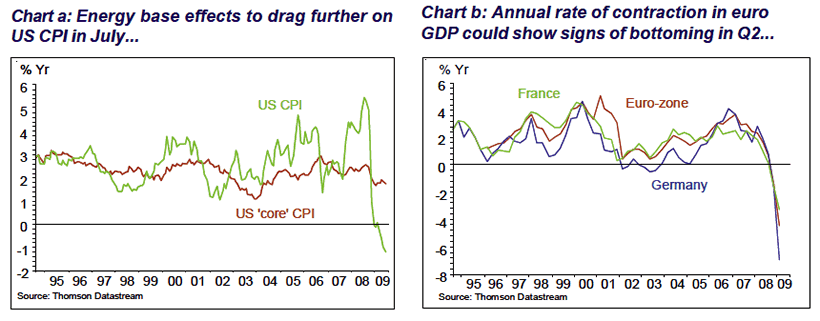Economics Weekly, FOMC Meeting and BoE Inflation Report Take Centre Stage
Economics / Global Economy Aug 10, 2009 - 03:13 AM GMTBy: Lloyds_TSB
After last week’s European central bank announcements, attention turns to Wednesday’s US FOMC meeting. We expect an unchanged 0-0.25% federal funds target range and for the policy statement to reiterate that this is likely to continue for an extended period. The statement may also touch on the exit strategy from QE, although the question of timing is likely to remain open. The Bank of Japan also announces its policy decision, amid signs that economic conditions have stopped deteriorating.
Elsewhere, Wednesday’s UK Inflation Report provides an opportunity for Governor Mervyn King to shed further light on the Bank’s decision to increase the size of its QErelated asset purchases. In the eurozone, the main data release is preliminary Q2 GDP, scheduled for Thursday.
The Bank of England’s August Inflation Report is published on Wednesday. At the press conference, Governor Mervyn King is likely provide more colour on last week’s decision to extend the Bank’s programme of asset purchases by £50bn, to £175bn. Mr. King has noted that, among other things, a boost from the stock cycle should support the short-term outlook for economic activity. Recent business surveys tend to support this view. But, as in May, we think Mr. King will continue to stress downside risks to activity, notably impaired credit provision to households and firms. Also on Wednesday, the UK publishes latest labour market data, where we anticipate a further rise in unemployment (of 30k on the claimant count measure).
The US sees a host of economic data releases this week, although events will be dominated by Wednesday’s FOMC meeting. We look for the target range for the federal funds rate to remain at 0-0.25% and, based on Chairman Ben Bernanke’s testimony to Congress recently, this policy stance is likely to extend well into next year. On balance, recent economic indicators have been positive, underlining the Fed’s central view that the pace of economic contraction is slowing. However, the Fed is likely to remain cautious on the prospects for economic recovery, recent optimism in financial markets notwithstanding. Among the data highlights is July’s CPI published on Friday, where we look for the “core” annual rate to fall to 1.6%, reflecting high levels of spare capacity. On the “headline” measure, we expect an annual CPI rate of –2.0%, as the peak in oil prices reached in July 2008, falls from the annual comparison.
In the eurozone, Thursday’s preliminary Q2 GDP data provide the main focus. Italy’s GDP figures have already been published, showing a slower (0.5%) pace of quarter-on-quarter contraction, versus a 2.7% fall in Q1. This week’s GDP data from Germany and France are also expected to show meaningful improvements. These are likely to show up in a slower pace of decline in fixed investment, a weaker drag from net exports and some possible stock-building. For the eurozone as a whole, we look for a 0.4% quarter-on-quarter fall in Q2 GDP, yielding an annual contraction of 5.0%. Beyond this, euro area industrial production, along with final July CPI data, are also due for release.
Mark Miller, Global Macroeconomist

For more information: Emile Abu-Shakra Manager, Media Relations Lloyds TSB Group Media Relations Tel 020 7356 1878 http://www.lloydstsbcorporatemarkets.com/
Lloyds TSB Archive |
© 2005-2022 http://www.MarketOracle.co.uk - The Market Oracle is a FREE Daily Financial Markets Analysis & Forecasting online publication.



